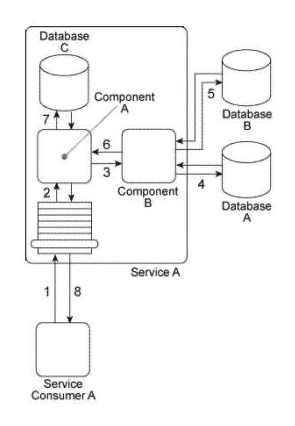Multiple Choice
Service Consumer A sends Service A a message containing a business document (1) . The business document is received by Component A, which keeps the business document in memory and forwards a copy to Component B (3) . Component B first writes portions of the business document to Database A (4) . Component B writes the entire business document to Database B and then uses some of the data values from the business document as query parameters to retrieve new data from Database B (5) . Next, Component B returns the new data back to Component A (6) , which merges it together with the original business document it has been keeping in memory and then writes the combined data to Database C (7) . The Service A service capability invoked by Service Consumer A requires a synchronous request-response data exchange. Therefore, based on the outcome of the last database update, Service A returns a message with a success or failure code back to Service Consumer A (8) . Databases A and B are shared and Database C is dedicated to the Service A service architecture.  There are several problems with this architecture: First, the response time of Database A is often poor, resulting in Component B taking too much time to provide a response to Component A. This results in Component A consuming too many runtime resources while it holds the business document in memory and it also causes unreasonable delays in responding to Service Consumer A. Additionally, Database B is being replaced with a different database product that supports a proprietary file format. This will disable the current interaction between Component B and the new Database B. What steps can be taken to solve these problems?
There are several problems with this architecture: First, the response time of Database A is often poor, resulting in Component B taking too much time to provide a response to Component A. This results in Component A consuming too many runtime resources while it holds the business document in memory and it also causes unreasonable delays in responding to Service Consumer A. Additionally, Database B is being replaced with a different database product that supports a proprietary file format. This will disable the current interaction between Component B and the new Database B. What steps can be taken to solve these problems?
A) The State Repository pattern is applied so that Component A can defer the business document data to a state database while it waits for a response from Component B. The Service Data Replication pattern is applied so that Component B can interact with a database that is replicated from the shared Database A. This will improve performance and reliability that will affect both Component A and Service Consumer A. Finally, the Legacy Wrapper pattern is applied so that Database B is wrapped in a standardized contract. This will establish a new wrapper utility service that will allow Database B to be replaced with a different database product without affecting Service A . Furthermore, the Data Format Transformation pattern can be applied within the new wrapper utility service to enable it to convert to and from the new proprietary file format.
B) The State Repository pattern is applied so that Component A can defer the business document data to a state database while it waits for a response from Component B. The Asynchronous Queuing pattern can be applied so that a messaging queue is established between Service Consumer A and Service A, thereby guaranteeing delivery and avoiding Service Consumer A from being tied up too long waiting for Service A to respond. Finally, the Data Format Transformation pattern can be applied to enable Component B to convert to and from the new proprietary file format introduced by the database product that is replacing Database B.
C) The Legacy Wrapper pattern is applied so that Database B is wrapped in a standardized contract. This will establish a new wrapper utility service that will allow Database B to be replaced with a different database product without affecting Service A . The Data Format Transformation pattern can be applied within the new wrapper utility service to enable it to convert to and from the new proprietary file format. The Service Data Replication pattern is applied so that Component B can interact with a database that is replicated from the shared Database B, regardless of what database product is used to replace Database B. The Service Abstraction principle can be further applied to hide the implementation details, including the changes mentioned in this solution, from Service Consumer A.
D) None of the above.
Correct Answer:

Verified
Correct Answer:
Verified
Q5: Service Consumer A sends a message to
Q6: Service A is an entity service that
Q7: Service A is a task service that
Q8: When Service A receives a message from
Q9: Service A is a utility service that
Q11: Service A is a task service that
Q12: Service A is an entity service that
Q13: The architecture for Service A displayed in
Q14: Service A is a task service that
Q15: It has been confirmed that Policy A